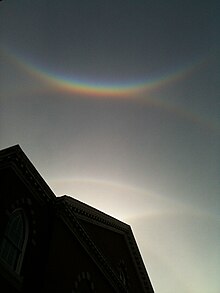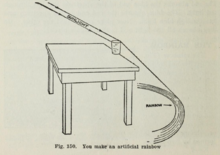130:
accounts for the wide color separation and the purity of color. The CZA can only form when the sun is at an altitude lower than 32.2°. The CZA is brightest when the sun is at 22° above the horizon, which causes sunlight to enter and exit the crystals at the minimum deviation angle; then it is also about 22° in radius, 1.5° in width. The CZA radius varies between 32.2° and 0°, getting smaller with rising solar altitude. It is best observed with solar altitudes of about 15°-25°; towards either extreme, it is vanishingly faint. When the Sun is observed above 32.2°, light exits the crystals through the bottom face instead, contributing to the almost colorless
20:
381:, (misidentified as a rainbow): "S-, a little boy of nine years old, was standing without any book in his hand, and freely idle; he was amusing himself with looking at what he called a rainbow upon the floor: The sun shone bright through the window; At last he found, that when he moved the tumbler of water out of the place where it stood, his rainbow vanished. immediately observed, that it was the water and the glas together that made the rainbow. "
122:
178:
should be situated at the edge of a table. The second refraction at the cylinder's side face is then a skew-ray refraction. The overall refraction turns out to be equivalent to the refraction through an upright hexagonal plate crystal when the rotational averaging is taken into account. A colorful artificial circumzenithal arc will then appear projected on the floor. Other
170:
129:
CZA is caused by ice crystals that form plate-shaped hexagonal prisms, in horizontal orientation. The light that forms the CZA enters an ice crystal through its flat top face, and exits through a side prism face. The refraction of almost-parallel sunlight through what is essentially a 90-degree prism
177:
A water glass experiment (known at least since 1920, cf. image on the right) may be used to create an artificial circumzenithal arc. Illuminating the top air-water interface of a nearly completely water-filled cylindrical glass under a shallow angle will refract the light into the water. The glass
106:(i.e. the width of the arc), azimuthal angular dispersion (ray bundling), and geometrical constraints. In effect, the CZA is brightest when the Sun is observed at about 20°.
109:
Contrary to public awareness, the CZA is not a rare phenomenon, but it tends to be overlooked, since it occurs so far overhead. It is worthwhile to look out for it when
91:. It has been called "a smile in the sky", its first impression being that of an upside-down rainbow. The CZA is one of the brightest and most colorful members of the
236:"Frequency analysis of the circumzenithal arc: Evidence for the oscillation of ice-crystal plates in the upper atmosphere," J. Opt. Soc. Am. 69(8), 1119–1122 (1979)
95:
family. Its colors, ranging from violet on top to red at the bottom, are purer than those of a rainbow because there is much less overlap in their formation.
98:
The intensity distribution along the circumzenithal arc requires consideration of several effects: Fresnel's reflection and transmission amplitudes,
173:
Analogous refraction demonstration experiment for the
Circumzenithal Arc. Here, it is mistakenly labelled as an artificial rainbow in Gilberts book
250:"Artificial circumzenithal and circumhorizontal arcs", M. Selmke and S. Selmke, American Journal of Physics (Am. J. Phys.) Vol. 85(8), p.575-581
506:
227:"Mémoire sur les halos et les phénomènes optiques qui les accompagnent", J. de l' École Royale Polytechnique 31(18), 1-270, A. Bravais, 1847
476:
157:. Its occurrence is rarer than solar CZA, since it requires the Moon to be sufficiently bright, which is typically only the case around
19:
153:
As with all halos, the CZA can be caused by light from the Moon as well as from the Sun: the former is referred to as a
137:
Because the phenomenon also requires that the ice crystals have a common orientation, it occurs only in the absence of
501:
83:
clouds, rather than from raindrops. The arc is located a considerable distance (approximately 46°) above the observed
471:
179:
92:
64:
99:
391:
366:
194:
103:
199:
377:
Practical
Education Vol. 1, Maria Edgeworth and Richard Lovell Edgeworth 1798, London, p.55-56
113:
are visible, since the same type of ice crystals that cause them are responsible for the CZA.
32:
378:
24:
477:
Spaceweather.com
Atmospheric optics expert Les Cowley created a diagram labeling the halos
323:
131:
142:
495:
486:
481:
121:
456:
80:
76:
72:
251:
318:
23:
A circumzenithal arc in Salem, Massachusetts, Oct 27, 2012. Also visible are a
138:
68:
425:
409:
281:
263:
125:
A Circumzenithal Arc. Seen in Mount Vernon, Washington. : June 10, 2024
482:
Images of artificial circumzenithal, circumhorizontal and suncave Parry arcs
451:
169:
158:
28:
466:
299:
16:
Optical phenomenon arising from refraction of sunlight through ice crystals
472:
Circumzenithal Arc Over Frisco, TX | 1-23-11 | Clouds 365 Project - Year 2
446:
204:
110:
390:
Leonardo Da Vinci, Anatomical drawings at
Windsor, folio 118r, ca 1508
209:
60:
365:
Gilbert light experiments for boys - (1920), p. 98, Experiment No. 94
345:
88:
168:
120:
18:
461:
84:
87:
and at most forms a quarter of a circle centered on the
319:"Who, What, Why: How common are upside-down rainbows?"
246:
244:
242:
59:, is an optical phenomenon similar in appearance to a
452:Atmospheric Optics - Circumzenithal Arc Gallery
300:"Ice halos: physics of the circumzenithal arc"
361:
359:
8:
462:Timelapse video of weak Circumzenithal Arc
317:Stokel-Walker, Chris (18 January 2016).
400:David K. Lynch and William Livingston.
220:
7:
457:Circumzenithal arc over Rome, Italy
14:
467:Physics of the circumzenithal arc
346:"OPOD - Lunar Circumzenithal Arc"
182:can be created by similar means.
141:and when there is no significant
63:, but belonging to the family of
426:"CZA - Effect of solar altitude"
282:"CZA - Effect of solar altitude"
447:Atmospheric Optics - About CZAs
487:Italian Aviation Meteo service
1:
507:Atmospheric optical phenomena
165:Artificial circumzenithal arc
523:
402:Color and Light in Nature.
155:lunar circumzenithal arc
149:Lunar circumzenithal arc
100:atmospheric attenuation
404:2nd ed, 2004 printing.
174:
126:
36:
172:
124:
31:(upper suncave), and
22:
428:. Atmospheric Optics
412:. Atmospheric optics
410:"Circumzenithal Arc"
352:. 16 September 2023.
304:iapetus.jb.man.ac.uk
288:. 16 September 2023.
270:. 16 September 2023.
264:"Circumzenithal Arc"
195:Circumhorizontal arc
104:chromatic dispersion
71:of sunlight through
53:upside-down rainbow
502:Geometrical optics
350:www.atoptics.co.uk
286:www.atoptics.co.uk
268:www.atoptics.co.uk
200:Circumscribed halo
175:
127:
43:, also called the
41:circumzenithal arc
37:
33:upper tangent arc
514:
436:
434:
433:
420:
418:
417:
394:
388:
382:
375:
369:
363:
354:
353:
342:
336:
335:
333:
331:
314:
308:
307:
296:
290:
289:
278:
272:
271:
260:
254:
248:
237:
234:
228:
225:
180:artificial halos
143:up- or downdraft
45:circumzenith arc
25:supralateral arc
522:
521:
517:
516:
515:
513:
512:
511:
492:
491:
443:
431:
429:
423:
415:
413:
407:
397:
389:
385:
376:
372:
364:
357:
344:
343:
339:
329:
327:
324:BBC News Online
316:
315:
311:
298:
297:
293:
280:
279:
275:
262:
261:
257:
249:
240:
235:
231:
226:
222:
218:
191:
185:
167:
151:
132:parhelic circle
119:
75:, generally in
17:
12:
11:
5:
520:
518:
510:
509:
504:
494:
493:
490:
489:
484:
479:
474:
469:
464:
459:
454:
449:
442:
441:External links
439:
438:
437:
421:
405:
396:
395:
383:
370:
355:
337:
309:
291:
273:
255:
238:
229:
219:
217:
214:
213:
212:
207:
202:
197:
190:
187:
166:
163:
150:
147:
118:
115:
15:
13:
10:
9:
6:
4:
3:
2:
519:
508:
505:
503:
500:
499:
497:
488:
485:
483:
480:
478:
475:
473:
470:
468:
465:
463:
460:
458:
455:
453:
450:
448:
445:
444:
440:
427:
422:
411:
406:
403:
399:
398:
393:
387:
384:
380:
374:
371:
368:
362:
360:
356:
351:
347:
341:
338:
326:
325:
320:
313:
310:
305:
301:
295:
292:
287:
283:
277:
274:
269:
265:
259:
256:
253:
247:
245:
243:
239:
233:
230:
224:
221:
215:
211:
208:
206:
203:
201:
198:
196:
193:
192:
188:
186:
183:
181:
171:
164:
162:
160:
156:
148:
146:
144:
140:
135:
133:
123:
116:
114:
112:
107:
105:
101:
96:
94:
90:
86:
82:
78:
74:
70:
67:arising from
66:
62:
58:
54:
50:
46:
42:
34:
30:
26:
21:
430:. Retrieved
424:Les Cowley.
414:. Retrieved
408:Les Cowley.
401:
386:
373:
349:
340:
328:. Retrieved
322:
312:
303:
294:
285:
276:
267:
258:
232:
223:
184:
176:
154:
152:
136:
128:
108:
97:
81:cirrostratus
73:ice crystals
56:
52:
48:
44:
40:
38:
57:Bravais arc
496:Categories
432:2007-04-23
416:2007-04-23
330:18 January
216:References
139:turbulence
69:refraction
55:, and the
159:full moon
117:Formation
29:Parry arc
205:Kern arc
189:See also
111:sun dogs
210:Sun dog
61:rainbow
51:), the
89:zenith
77:cirrus
65:halos
392:link
379:link
367:link
332:2016
252:link
93:halo
39:The
85:Sun
79:or
49:CZA
498::
358:^
348:.
321:.
302:.
284:.
266:.
241:^
161:.
145:.
134:.
102:,
27:,
435:.
419:.
334:.
306:.
47:(
35:.
Text is available under the Creative Commons Attribution-ShareAlike License. Additional terms may apply.


